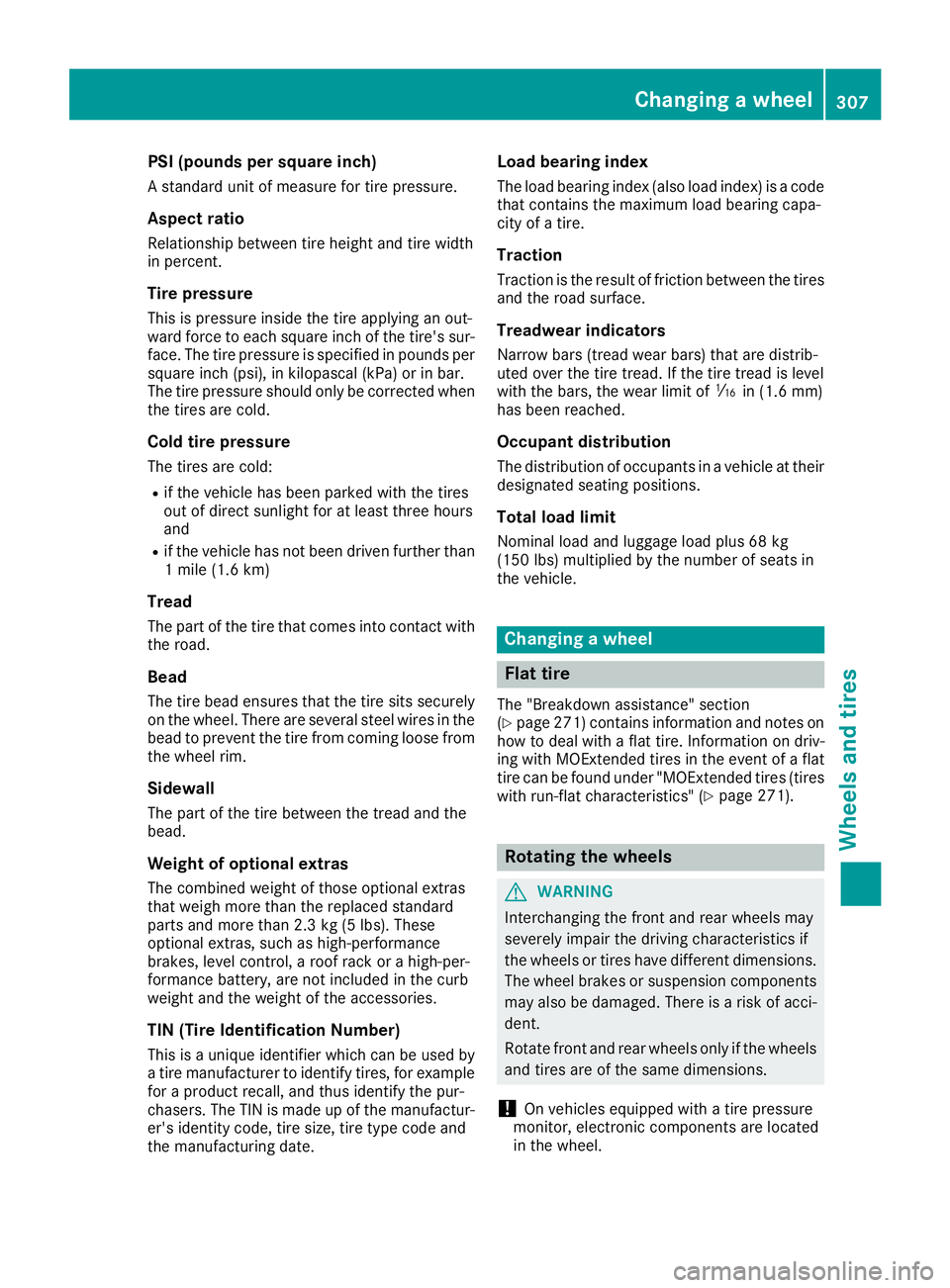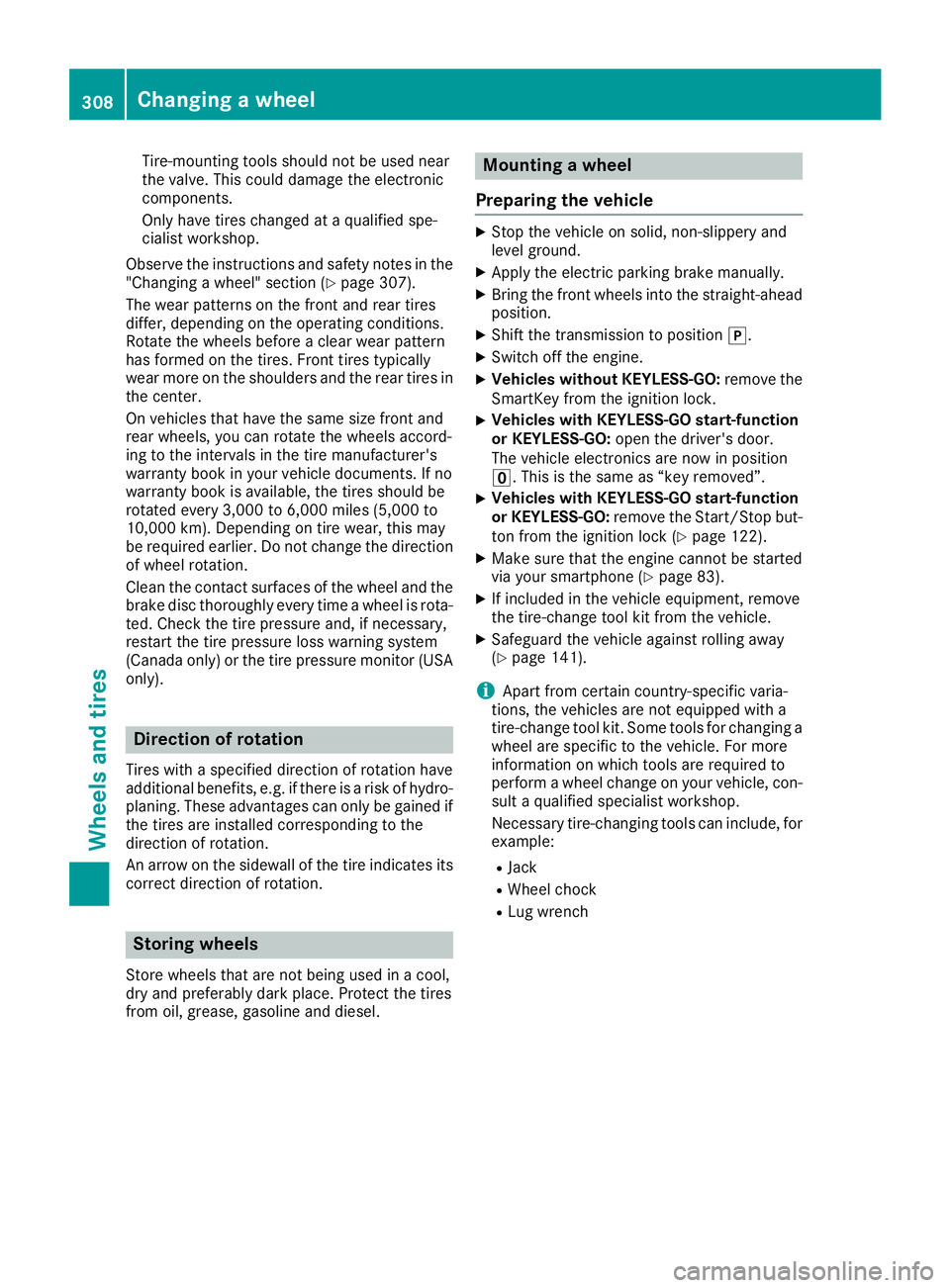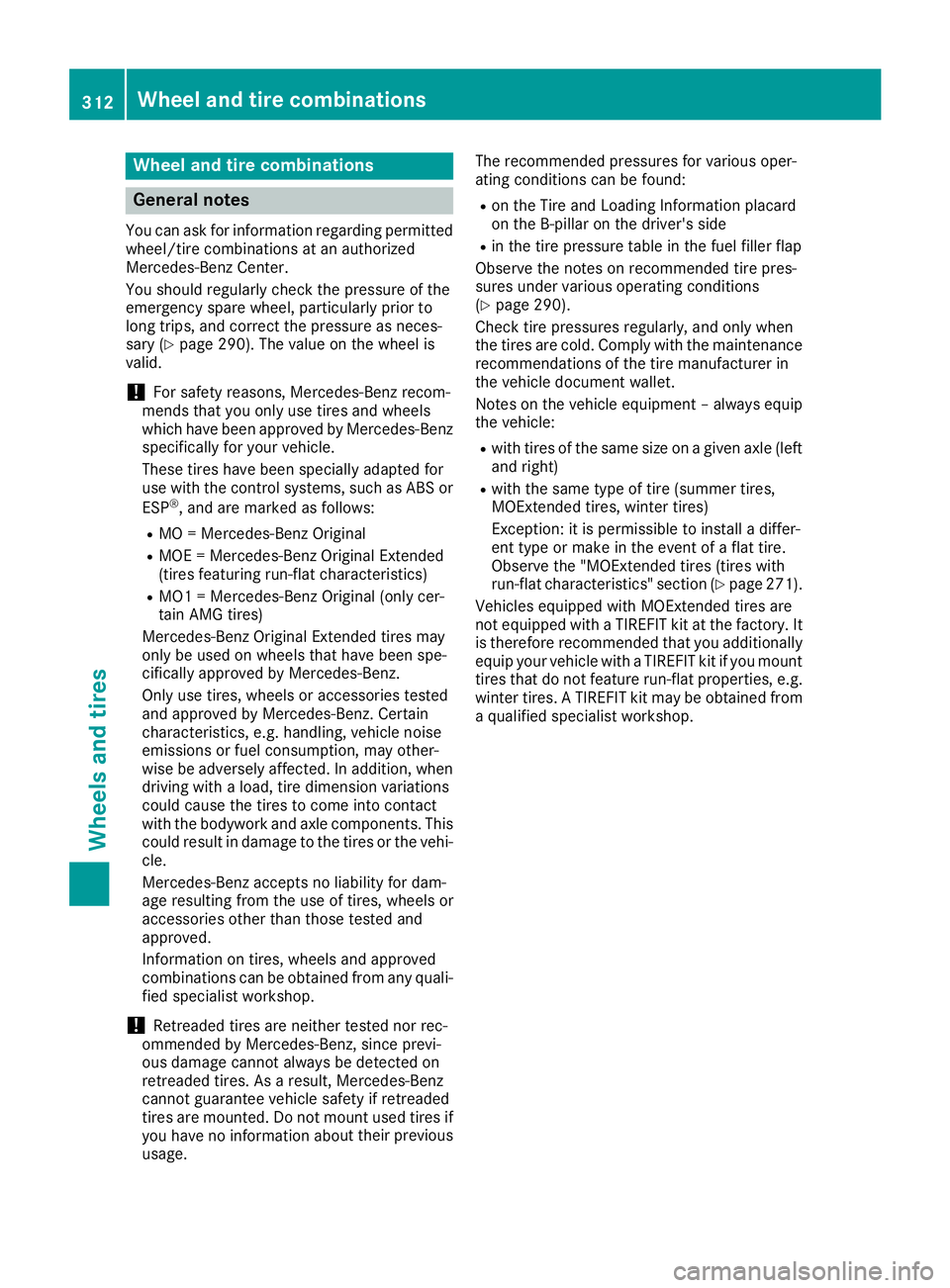Page 309 of 326

PSI (pounds per squar ei nch)As tandard unit of measure for tire pressure.
Aspect ratio Relationship between tire height and tire width
in percent.
Tire pressure This is pressure inside the tire applying an out-
ward force to each square inch of the tire's sur-
face. The tire pressure is specified in pounds per
square inch (psi), in kilopascal (kPa) or in bar.
The tire pressure should only be corrected when
the tires are cold.
Cold tire pressure The tires are cold: R
if the vehicle has been parked with the tires
out of direct sunlight for at least three hours
and R
if the vehicle has not been driven further than
1m ile (1.6 km)
Tread The part of the tire that comes into contact with
the road.
Bead The tire bead ensures that the tire sits securely
on the wheel. There are several steel wires in the
bead to prevent the tire from coming loose from
the wheel rim.
Sidewall The part of the tire between the tread and the
bead.
Weight of optional extras
The combined weight of those optional extras
that weigh more than the replaced standard
parts and more than 2.3 kg (5 lbs). These
optional extras, such as high-performance
brakes, level control, ar oof rack or ah igh-per-
formanc eb attery, are not included in the curb
weight and the weight of the accessories.
TIN (Tire Identification Number)
This is au nique identifier which can be used by
at ire manufacturer to identify tires, for example
for ap roduct recall, and thus identify the pur-
chasers. The TIN is made up of the manufactur-
er's identity code, tire size, tire type code and
the manufacturing date. Load bearing index The load bearing index (also load index) is ac ode
that contains the maximum load bearing capa-
city of at ire.
Traction Traction is the result of friction between the tires
and the road surface.
Treadwear indicators Narrow bars (tread wear bars) that are distrib-
uted over the tire tread. If the tire tread is level
with the bars, the wear limit of �
Page 310 of 326

Tire-mounting tools should not be used near
the valve. This could damage the electronic
components.
Only have tires changed at aq ualified spe-
cialist workshop.
Observe the instructions and safety notes in the
"Changing aw heel" section ( Y
page 307).
The wear pattern sont he front and rear tires
differ, depending on the operating conditions.
Rotate the wheels before ac lear wear pattern
has formed on the tires. Fron tt ires typically
wear more on the shoulders and the rear tires in
the center.
On vehicles that have the same size front and
rear wheels, you can rotat et he wheels accord-
ing to the intervals in the tire manufacturer's
warranty book in your vehicle documents. If no
warranty book is available, the tires should be
rotated every 3,000 to 6,000 miles (5,000 to
10,00 0k m) .D ependin gont ire wear, this may
be required earlier. Do not change the direction
of wheel rotation.
Clean the contact surfaces of the wheel and the
brake disc thoroughly every time aw heel is rota-
ted. Check the tire pressure and, if necessary,
restart the tire pressure loss warning system
(Canada only) or the tire pressure monitor (USA
only).
Direction of rotation Tires with as pecified direction of rotation have
additional benefits ,e .g. if there is ar isk of hydro-
planing. These advantages can only be gained if
the tires are installed corresponding to the
direction of rotation.
An arrow on the sidewall of the tire indicates its
correc td irection of rotation.
Storing wheels Stor ew heels that are not being used in ac ool,
dry and preferably dark place. Protec tt he tires
from oil, grease, gasoline and diesel. Mounting aw heel
Preparing the vehicle X
Stop the vehicle on solid, non-slippery and
level ground. X
Apply the electric parking brake manually. X
Bring the front wheels into the straight-ahead
position. X
Shift the transmission to position �] .X
Switch off the engine. X
Vehicles without KEYLESS-GO: remove the
SmartKey from the ignition lock. X
Vehicles with KEYLESS-GO start-function
or KEYLESS-GO: open the driver's door.
The vehicle electronics are now in position
�
Page 314 of 326

Whee la nd tire combinations
General notes You can ask for information regarding permitted
wheel/tire combinations at an authorized
Mercedes-Benz Center.
You should regularl yc heck the pressure of the
emergency spare wheel, particularly prio rt o
long trips, and correct the pressure as neces-
sary ( Y
pag e2 90). The valu eont he wheel is
valid.
! For safety reasons, Mercedes-Benz recom-
mends that you only use tires and wheels
which have been approved by Mercedes-Benz
specifically for you rv ehicle.
These tires have been speciall ya dapted for
use with the control systems, such as ABS or
ESP ®
,a nd are marked as follows:R
MO = M ercedes-Benz OriginalR
MOE = M ercedes-Benz Original Extended
(tires featuring run-fla tc haracteristics)R
MO1 = M ercedes-Benz Original (only cer-
tain AMG tires)
Mercedes-Benz Original Extended tires may
only be use donw heels that have been spe-
cifically approved by Mercedes-Benz.
Only use tires, wheels or accessories tested
and approved by Mercedes-Benz. Certain
characteristics, e.g. handling, vehicl en oise
emissions or fuel consumption, may other-
wis ebea dversely affected .Ina ddition, when
driving with al oad, tire dimension variations
coul dc aus et he tires to come into contact
with the bodywork and axle components. This
coul dr esult in damage to the tires or the vehi-
cle.
Mercedes-Benz accepts no liability for dam-
age resulting from the use of tires, wheels or
accessories other than those tested and
approved.
Informatio nont ires, wheels and approved
combinations can be obtained from any quali-
fied specialist workshop.
! Retreaded tires are neither tested nor rec-
ommende dbyM ercedes-Benz, since previ-
ous damage cannot alway sbed etected on
retreaded tires. As ar esult, Mercedes-Benz
cannot guarantee vehicl es afety if retreaded
tires are mounted .Don ot mount use dt ires if
you have no information abo ut thei r previous
u
sage. The recommende dp ressures for various oper-
ating conditions can be found: R
on the Tire and Loading Informatio np lacard
on the B-pillar on the driver's side R
in the tire pressure tabl eint he fuel filler flap
Observe the notes on recommende dt ire pres-
sure su nder various operating conditions
( Y
pag e2 90).
Check tire pressures regularly ,a nd only when
the tires are cold. Comply with the maintenance
recommendations of the tire manufacturer in
the vehicl ed ocument wallet.
Notes on the vehicl ee quipment –a lway se quip
the vehicle: R
with tires of the same size on ag ive na xle (left
and right) R
with the same type of tire (summer tires,
MOExtended tires, winter tires)
Exception: it is permissible to instal lad iffer-
ent type or make in the event of af lat tire.
Observe the "MOExtended tires (tires with
run-fla tc haracteristics" section ( Y
pag e2 71).
Vehicles equipped with MOExtended tires are
not equipped with aT IREFIT kit at the factory .I t
is therefore recommende dt hat you additionally
equip you rv ehicl ew ith aT IREFIT kit if you mount
tires that do not feature run-fla tp roperties, e.g.
winter tires. AT IREFIT kit may be obtained from
aq ualified specialist workshop.312
Whee la nd tire combinations
Wheels and tires